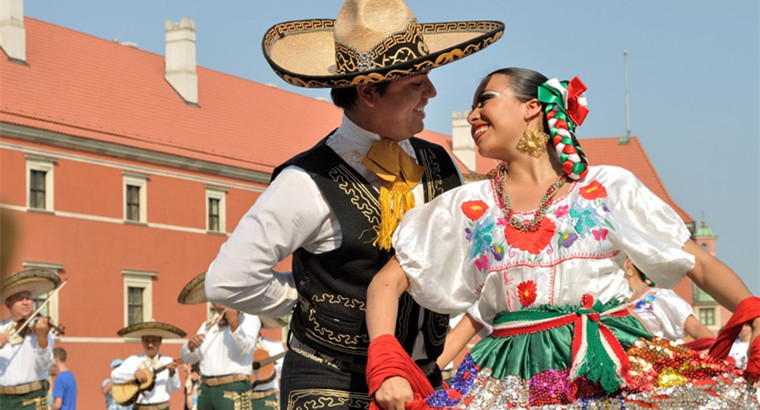Dance is often a form of self-expression, a medium to tell stories, and an art form depicting the culture and history of the place it came from. For Mexico, dance has always been an integral part of their culture. It portrays the indigenous values of Mexico as well as influences from the African and European traditions.
Mexican dance survived the ban during the Spanish colonization era while integrating the colors of Spanish culture into its routine. Let’s take a look at some of the most famous Mexican dance styles and their impact on Mexican culture.
What Is Mexico’s Dance?
Mexico’s dance is best represented by Mariachi music or Mexican traditional music combined with elaborate and colorful attire and the use of different types of instruments.
Folk dances everywhere are a celebratory portrayal of a country’s history, religion, and cultural and social beliefs. Mexican folk dances or Folklorico dances celebrate Mexico’s cultural roots and are performed as a part of their traditional rituals.
Mexico has a rich variation of folk dances, each originating from different parts of the country. Not only are they a window to the country’s rich cultural tradition, but they are also based on the common theme of religion, love, and communion with nature.
10 Mexican Dance Styles
#1. Jarabe Tapatio
Jarabe Tapatio is undoubtedly the symbol of Mexican dance in the world. Also known as “The Mexican Hat Dance,” Jarabe Tapatio originated in Jalisco, Mexico, and was declared the national dance of the country in the year 1924 in an effort to bring the different cultures together.
It’s a courtship dance where the man tries to woo the female while the female ignored his first few advances and finally accepts the proposal. The male costume involves a Charro suit with the signature sombrero while the female wears a china poblana dress.
We see the male placing his sombrero on the ground while they both dance around it. Near the end, the female picks the sombrero and uses it to shield their faces from the audience, indicating they’ve sealed the deal with a kiss. This is the signature step involved in every Jarabe Tapatio dance.
#2. Chinelos
The word “chinelos” means “disguise” in Nahuatl. Chinelos was first performed in the carnivals during the Spanish colonization to mock the Europeans. The dancers would disguise themselves as fair-skinned Europeans with elaborate costumes and imitated the Europeans and their extravagant mannerisms.
The authorities didn’t favor the mockery and tried to suppress the uprising revolt. While they succeeded in various states of New Spain, the dance form survived in some small towns like Tlaxcala, Puebla, and Morelos.
Today, the dance is symbolic of the state of Morelos and is performed during national festivals like Independence Day and other private parties.
#3. La Conquista
La Conquista, popularly known as Baile De La Conquista in Mexico, is a traditional dance and drama form that tells the story of the Spanish invasion. It sings the heroic tale of Prince Tekum who defended the kingdom against Pedro de Alvarado who invaded the K’iche’ Kingdom under the order of Hernán Cortés.
The dance is performed to celebrate their roots, their identity, and to remember the history of their war against exploitation. The dance is popular in Michoacán and Jalisco states of Mexico.
#4. Danza del Venado
Danza del Venado is native to the Yaqui village of Sonara. Its also called the “deer dance” in layman’s terms and can be easily identified by the presence of deer antlers on the performer’s head.
Deer is sacred to the people of Yaqui, and this dance celebrates a deer’s journey through life and death. The music builds up with the story of the deer, making it quite entertaining to watch.
#5. Los Voladores de Papantla
It is believed that Los Voladores de Papantla was performed as a prayer to the four grandfathers who live in the four cardinal points to ask them to bless the land with rainfall and save the people from severe drought.
The dance is one of the most terrifying ones to watch as the four dancers spiral down a 30 feet tall pole with nothing but ropes tied to them. The fifth performer stays on the top playing the flute to please the grandfathers.
UNESCO identified Los Voladores de Papantla with an “Intangible Cultural Heritage” tag.
#6. Concheros
Concheros is primarily an indigenous art form of Mexico in which the performers are clad in feathered headdresses and body paints. Created in the 1820s, this dance was popularized during the Chicano movement of the ’60s and ’70s. Concheros represents the centuries of fight against colonization and cultural suppression.
Every movement of the dance has meaning behind it. Each step represents different forces of our nature, like the wind and the rain, and every color reflects the sacred elements like fire, water, and earth.
The dance is typically accompanied by drums and flutes, and you can even find the European armadillo shell lutes in the mix.
#7. Matlachines
Matlachines is inspired by European ritual folk dance and was brought to the Atlantic by the Spanish to raise awareness and convert Native Americans to Christianity. It tells the stories of Christian conversions, the battle between Christianity and Paganism, and the victory of Christianity.
Matlachines dance usually involves two dance groups, each has performers playing five important roles. The Monarco represents the leaders, the Malinche or the virgin represents purity, the toro (bull) represents evil, and then there is a comical elder man (clown) and the Matachines (twelve dancers). The wooden shoes and vibrant colorful costumes are iconic of Matlachines dancers.
#8. Moros y Cristianos
The literal translation of this phrase means “Moors and Christians.” This dance form was performed to commemorate the war between the Moors and the Christians during the Reconquista period.
Moros y Cristianos isn’t a Mexican dance but comes from the European monks. Today, the dance is performed as a part of festivals with mock battles depicting the conquering of Spanish towns. The entry of the dancers is accompanied by loud upbeat music and firecrackers.
#9. Danza de los Viejitos
Danza de los Viejitos is the dance of elderly men created in the 20th century as a mockery of upper-class Spanish society. Four men clad in indigenous clothing equipped with traditional instruments represent the four elements of nature — earth, air, fire, and water.
The men carry the machita or mask while the women carry fans as dance props. Both are adorned with wooden shoes to make each step sound impactful.
#10. Danza de los Diablos
We often talk about the European heritage of Mexico, a bitter-sweet gift of colonization, but tend to forget about the African influence. The Spanish brought African slaves with them during the colonization period, and the Danza de los Diablos symbolizes the freedom of Africans from the wrath of Spanish slave owners.
All performers wear a similar attire and mask with the exception of the Mayor, the lead performer portraying the evil, who wears a more elegant attire to match the character’s status.
The dance is majorly performed on Día de Muertos, or the day of the dead, in Mexico.










